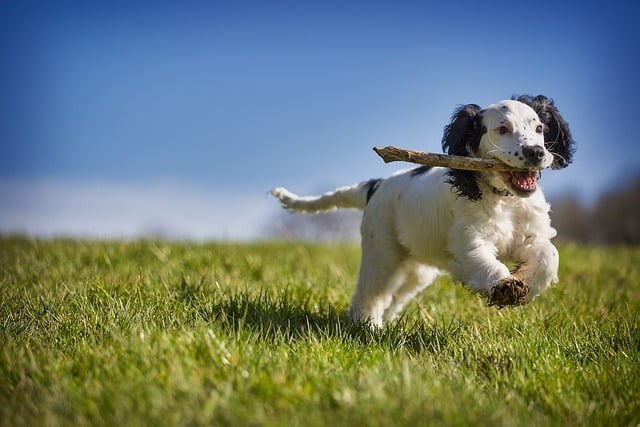How Dogs Learn Their Name | Best Tips To Learn
Ever wonder why your furry friend perks up at the sound of their name? Learning their name is a mix of instinct, learning, and love. Dogs turn a simple word into a powerful way to talk to us.

Teaching a dog its name is a key part of puppy training. It’s the first step in teaching them to understand us. This step is important for obedience and building a strong bond with your dog.
We’re going to explore how dogs learn their names. We’ll look at canine learning and give tips for pet parents. Get ready for a fun journey of discovery.
Key Takeaways
- Dog name recognition is a crucial first step in puppy training
- Canine learning involves positive reinforcement and repetition
- Pet name association strengthens the bond between dogs and owners
- Consistent use of a dog’s name enhances communication
- Understanding canine cognition helps in effective name training
The Importance of Teaching Your Dog Its Name
Teaching your dog its name is key in canine name training. It helps with communication and prepares for future dog commands. Let’s see why it’s vital for you and your furry friend.
Building a Foundation for Communication
Your dog’s name is its first verbal cue. When it answers its name, it starts two-way communication. This is crucial for all future training and helps your dog know when you’re talking to them.
Enhancing Your Bond with Your Pet
Learning its name is more than training. It’s a way to bond with your pet. As your dog links its name with good times, it grows to trust and love you. This bond is crucial for a happy, well-adjusted pet.
Setting the Stage for Further Training
Knowing its name is the first step in learning other dog commands. Once your dog knows its name, you can teach more complex things. This skill helps your dog pay attention to you in different places. It makes teaching new behaviors and staying in control easier.
“A dog’s name is the key that unlocks the door to successful training and a lifetime of companionship.”
By spending time on canine name training, you’re doing more than teaching a simple command. You’re building a strong base for a well-behaved, responsive, and happy dog. This will make living with your dog a joy for years.
Understanding Canine Learning Processes
Dogs are great at learning new things. They learn by using operant conditioning. This means they learn by getting rewards for doing things.
Positive reinforcement is key in training dogs. When you give treats or praise for listening to its name, you help it remember. This makes it want to listen again.

Clicker training uses operant conditioning too. A clicker marks good behavior. This helps dogs know what they’re getting rewarded for. It’s great for teaching names.
Dogs are really good at hearing and can tell sounds apart. By always saying its name when it does something good, you help it remember. It learns to pay attention when it hears its name.
| Learning Process | Description | Application in Name Training |
|---|---|---|
| Operant Conditioning | Behavior modification through consequences | Rewarding response to name |
| Positive Reinforcement | Encouraging desired behaviors with rewards | Treats or praise for name recognition |
| Clicker Training | Using a click sound to mark correct behaviors | Clicking when dog responds to name |
| Auditory Learning | Processing and remembering sounds | Recognizing name as a distinct sound |
Knowing how dogs learn helps you teach them their name better. By using what they naturally do, you can make learning fun and easy for them.
How Do Dogs Learn Their Name: The Step-by-Step Process
Teaching a dog its name is key to good communication and training. We’ll look at how to name a dog and make sure they listen. This step is very important.
Choosing the Right Name
Pick a short, easy name for your dog. Make sure it’s not like common commands. This makes it easier for your dog to learn.
Creating Positive Associations
Link your dog’s name with good things. Say it happy and give treats or praise right away. This makes your dog happy to hear its name.

Consistency in Repetition
Say your dog’s name a lot every day. Use it at mealtime, playtime, and when you give attention. This helps your dog learn its name well.
Rewarding Desired Responses
Give your dog a reward when it listens to its name. Use treats, praise, or play. As it gets better, give rewards less often.
| Step | Action | Purpose |
|---|---|---|
| 1 | Choose a short, distinct name | Ensure clarity and ease of recognition |
| 2 | Create positive associations | Encourage enthusiastic responses |
| 3 | Repeat name consistently | Reinforce name recognition |
| 4 | Reward desired responses | Strengthen name-response connection |
Follow these steps to teach your dog its name well. You’ll build a strong base for more training later.
Effective Techniques for Name Training
Teaching your dog its name is key in obedience training. It makes them more responsive and strengthens your bond.
Begin with short, frequent training times. Call your dog’s name in a happy voice and give them treats or praise when they come. This makes them think of their name as a good thing.
Make recall training a part of your daily life. Call your dog’s name during fun times, meals, or walks. Give them a treat or some love when they come. This helps them remember their name and come to you better.
- Use high-value treats during initial training sessions
- Gradually phase out treats and replace with verbal praise
- Practice in different environments to generalize the skill
Socialization is important for name training. Meet new people and ask them to call your dog by its name. This helps your dog see its name as a positive thing in different places.
“A dog’s name should be a beacon, guiding them back to you no matter the distraction.”
Being consistent is crucial in dog name training. Always use the same name and avoid nicknames when training. With time and effort, your dog will learn to come when called, making further training easier.
Common Challenges in Teaching Dogs Their Names
Teaching your dog its name is key in training. But, it can be tough. Let’s look at common problems and how to beat them.
Overcoming Distractions
Dogs love to explore. When teaching them their name, you’re up against fun things like toys and treats. Start training in a quiet spot. Then, add small distractions as your dog gets better. This makes them focus and remember their name.
Dealing with Selective Hearing
It seems like your dog only listens when they want to. This can be hard. Make hearing their name a reward. Use treats or toys they love when practicing. This makes them want to listen when called.
Addressing Confusion with Similar Sounds
Your dog might mix up their name with other sounds. This makes it hard to remember. Pick a name that stands out from other words. For example, “Kit” might sound like “sit.” Use a clear, happy voice to help them know their name.
- Practice in different places
- Use different tones and volumes
- Make hearing their name a good thing
Be patient. With regular practice and treats, your dog will learn their name.
Reinforcing Name Recognition Through Daily Activities
Strengthening your dog’s name recognition is key. Use dog verbal cues in daily life for practice. This makes learning fun for your pet.
Incorporating Name Use in Playtime
Playtime is great for practicing your dog’s name. Call their name before playing or throwing a toy. This links their name with fun activities. Praise them when they answer to make the link stronger.
Integrating Name Recognition with Other Commands
Link name recognition with other commands. Say their name, then a command like “sit” or “stay”. This shows them their name means to listen. Practice this often to make it a habit.
Practicing in Various Environments
Train your dog in different places like parks or friends’ houses. This shows them their name works everywhere, not just at home. Start in quiet spots and move to busier places as they get better.
- Use their name before meals
- Say their name during grooming sessions
- Call them by name when entering or leaving the house
Use these methods often to make your dog’s name recognition strong. Remember, be patient and use positive reinforcement. This will make communication easier and strengthen your bond.
Conclusion
Teaching your dog its name is a key part of puppy training. It builds the foundation for all future learning and strengthens your bond. Dogs learn their name through positive experiences and repetition.
Consistency is key in teaching your dog its name. Use your pup’s name often during playtime, feeding, and daily activities. This helps make the connection between the sound and good things.
Be patient and keep training sessions short and fun. As you progress, you’ll see that a dog who knows its name is easier to train in other areas. This skill opens doors for more advanced commands and behaviors.
Keep practicing in different settings to make sure your dog understands. By following the tips in this guide, you’ll soon have a furry friend who comes running at the sound of their name. This is a big step in your journey together. It makes communication clear and builds a strong bond for life.
FAQ
Why is it important to teach a dog its name?
Teaching a dog its name helps with communication and training. It builds a strong bond and makes obedience better. A dog that knows its name listens better to its owner.
How do dogs learn their names?
Dogs learn their names through operant conditioning. This means they link their name with good things. Using treats, praise, and clicker training helps them learn.
What are some effective techniques for teaching a dog its name?
Good ways to teach a dog its name include making it a positive thing. Use treats and toys as rewards. Add the name to play and daily life. Practice in different places and mix it with other commands.
How can I overcome distractions during name training?
Overcoming distractions is hard. Start training in a quiet place with few distractions. Then, add more distractions as the dog gets better. Reward the dog for paying attention.
How long does it typically take for a dog to learn its name?
How long it takes depends on the dog’s age, breed, and how smart it is. With regular and positive training, most dogs learn their names in a few weeks to a few months. Be patient, as some dogs learn slower.
Can I change a dog’s name after it has already learned its original name?
Yes, you can change a dog’s name with patience and consistent training. Start using the new name and reward the dog for responding to it.
How can I reinforce name recognition in my daily routine?
Use the dog’s name in daily activities like playtime and before treats. This makes the name stronger in their mind. Using the name often helps them respond better.
Subscribe to our weekly newsletter below and never miss the latest article.








